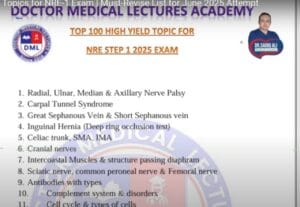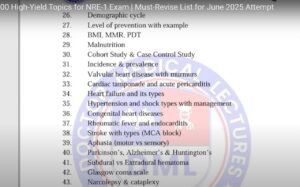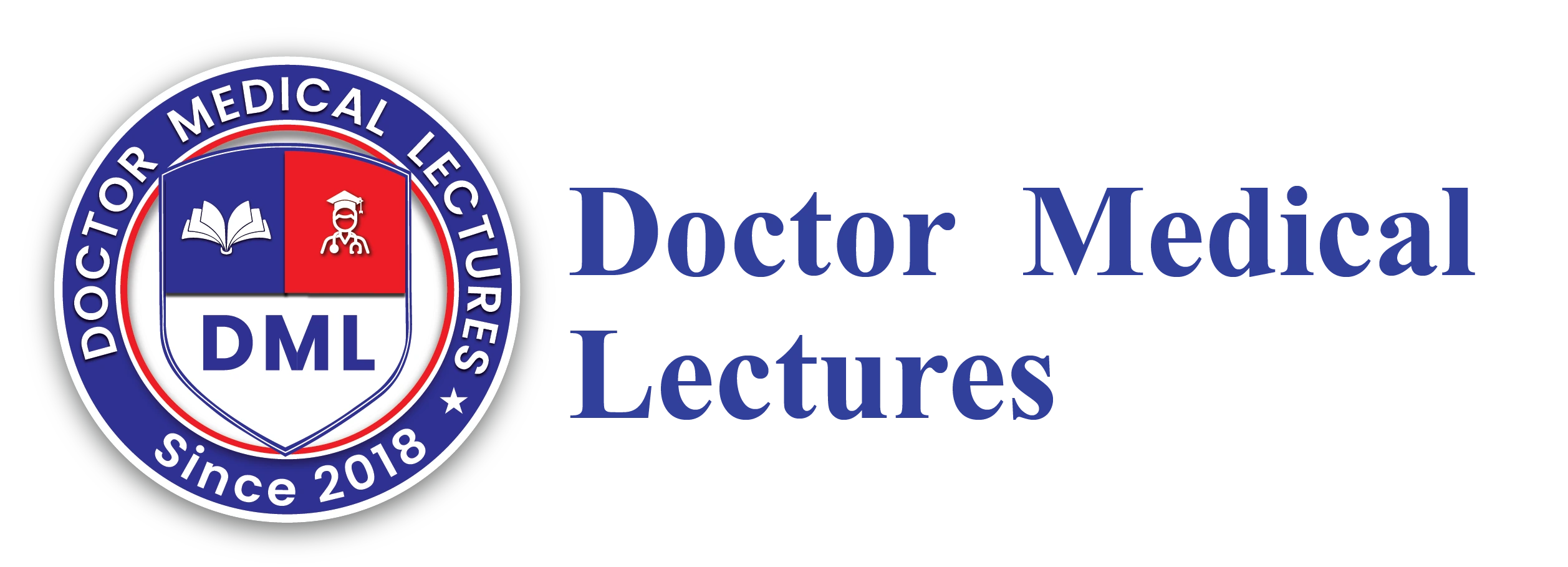Top 100 High Yield Topics for NRE-1 Exam
The National Registration Examination (NRE-1) conducted under the direction of the Pakistan Medical and Dental Council (PMDC) is a lengthy examination that tests the clinical and theoretical knowledge for medical student. Success in this exam depends on proper preparation and a strong understanding of the most popular subjects.

Dr. Sadiq Ali’s guideline focuses on the most commonly tested areas that will be covered in the exam. The subjects are further classified according to medical disciplines. Below is an extensive description of the 100 most significant areas.
1. Cardiology (Heart Diseases)
Valve Disorders and Murmurs
Heart valve disorders, particularly mitral stenosis and mitral regurgitation, as well as Aortic regurgitation and stenosis, are vital locations. It is essential for students to be aware of the reasons of the condition, their common trigger and the signs that are typical of heart disease including murmurs, and the sound. Knowing where each murmur may be most efficient to detect and how they change when you move your body, such as the squatting and Valsalva movements is vital in order to be able to respond MCQ as well as medical related case based questions.
Cardiac Tamponade and Pericarditis
These are medical emergencies for which an early diagnosis could save lives. The symptoms of cardiac tamponade include Beck’s triad: hypotension, muffled heart sounds, and distension of the neck veins.
Recognizing the distinction between acute and chronic pericardial inflammation, pericardial pressure rub ECG signs as well as the significance of pericardiocentesis are vital. Most inquiries focus on the diagnostic techniques and distinguishing features of myocardial ischemia.
Heart Failure Types
The categorization of Systolic diastolic as well as right sided and left sided. Left sided heart failure is a fundamental issue. The most important topics are Ejection friction variants, BNP levels, symptoms and treatments that include ACE inhibitors beta blockers, along with diuretics. In addition, you must be aware of peripheral edema and NYHA classification system as well as the treatment options for medical devices like ICDs in serious instances.
Types of Shock
This is a frequent issue when dealing with medical emergency situations. Discover the cause of hemodynamic profile, the symptoms and treatment for hypovolemic, cardiogenic (e.g. or anaphylactic septic) and obstructive. Clinical scenarios demand one to recognize those types based on cardiac output and blood pressure and the response to the resuscitation of liquids.
2. Respiratory System
Asthma as well as chronically obstructive respiratory disorder are two of the most frequent chronic obstructive diseases. Asthma sufferers are prone to reversible constriction of the bronchial passages as an eosinophilic inflammation, and the reaction to bronchodilators plays an important part. When it concerns COPD the three emphysema types, chronic and bronchitis are distinct by their diagnosis and features. It is essential to be aware of the patterns of spirometry, the treatment steps in accordance with GOLD guidelines along with complications such as the corpulmonale.
Lung Cancer
SCLC and NSCLC (including SCC and adenocarcinoma) must be studied in order to identify their possible danger factors, histology as well as the manifestations in clinical terms, as well as any symptoms. SCLC, for example is found in the central area and often causes paraneoplastic diseases like SIADH. NSCLC can be related to PTHrP induced hypercalcemia. Examiners often assess chemotherapy and surgical resection guidelines as treatment options.
Pleural Disorders
Conditions like pneumothorax, empyema, and pleural effusion are all important subjects that require understanding the pathophysiology, imaging findings, and treatments. Additionally, it is crucial to be aware of the differentiators between transudative and exudative effusions, which are based on Light’s criteria. Furthermore, knowing the recommendations for chest tube insertion plays a vital role in managing these conditions effectively.
Pneumoconiosis
This includes diseases like asbestosis, silicosis, and pneumoconiosis for coal miners. Analyze the risk of exposure to occupational dangers and radiologic aspects and chronic issues like massive fibrosis or mesothelioma. This can be a very high rate of success in the field of pathology and questions regarding integration of public health.
3. Endocrinology
Be aware of adenomas which release hormones such as prolactinomas, and excess growth hormone in acromegaly as well as related disorders such as diabetes insipidus, or SIADH. It’s common for medical issues to necessitate the identification of vision field impairments (e.g. bitemporal hemianopia in pituitary tumors that are malignant) or lab findings, such as a lower the serum osmolality and increased urine osmolality in of SIADH.
Diabetes Mellitus
It covers types 1 as well as 2 diabetes. Types 1 and 2 are included. It is primarily concerned with the causes of the condition, its diagnosis needs and treatment methods. The consequences of diabetic ketoacidosis such as hyperosmolar hyperglycemic disorder and neuropathy. the possibility of developing cardiovascular diseases as well as neuropathy is worth examining more deeply.
Multiple Endocrine Neoplasia (MEN) Syndromes
The three categories include MEN1, MEN2A, and MEN2B and each is afflicted with its own type of cancer. In particular, MEN1 includes parathyroid, pituitary, pancreatic tumors as well as. MEN2 disorders are a result of the mutation in RET along with medullary thyroid cancer and Pheochromocytoma. Understanding the connection between the cancers and the genetic cause is frequently studied.
Cushing Syndrome
The distinction from ACTH dependent (Cushing disease and Ectopic ACTH) as well as causes which are not dependent. Discover the tests for dexamethasone suppressive clinical features such as moon facies, an excessive weight loss along with the skin’s striae. Doctors may need to perform surgery or provide medical treatments to stop cortisol production.

4. Neurology
Stroke Syndromes
Ischemic strokes among those of MCA, ACA, and PCA are characterized by different neurodegenerative impairments. When the dominant hemisphere is damaged, MCA strokes typically cause aphasia and contralateral hemiparesis. Imaging (CT in contrast to. MRI) and the management (thrombolysis as well as mechanical thrombectomy) and other prevention strategies (aspirin or statins) are essential.
Aphasia Types
Aphasia can be that refers to impairment in the language due to cortical damage. The aphasia of Broca may affect the speaking language (frontal lobe) and Wernicke’s can be one of the problems with the capacity to understand (temporal cerebral the lobe). The most frequently asked questions are about finding the symptoms to the exact location of damage in the brain.
Neurodegenerative Diseases
Alzheimer’s disease shows because Alzheimer’s disease is defined by the loss of memory and beta amyloid plaques, and Parkinson’s disease is manifested as bradykinesia, the resting tremors as well as Lewy body. Huntington’s disease is characterized by chorea and repeated CAG trinucleotide expansions. The key is to comprehend genetics with progress in clinical care along with current methods to manage.
5. Hematology
Types of Anemia
It is a result of iron deficiency (microcytic) megaloblastic (B12/folate deficit) as well as hemolytic anemias (hereditary spherocytosis, and G6PD) and anemia as a result of an illness that is chronic. Find out the patterns in the lab and results of peripheral smears along with the reason of the results for each.
Leukemias
Acute (ALL, AML) vs. chronic (CML, CLL) leukemias can be distinguished through the aging process in addition to a testing of blood (Auer rods in AML) as well as genes (e.g., Philadelphia chromosome in CML). Methods of treatment (e.g., ATRA in APL) may also be examined.
Clotting Disorders
Hemophilia A (factor VIII) and B (factor IX) along with DIC, TTP, and ITP and ITP are essential. Understanding the path of clotting, as well as the changes in PT/PTT, and symptoms of bleeding or. the presence of thrombosis, can aid in addressing questions related to the case.
Hemoglobin Oxygen Dissociation Curve
Pay attention to the changes the curve leaves (e.g. acidosis elevated CO2 or fever) and also the left (e.g. alkalosis or the Hb of the fetus ). This widely known biological concept helps determine oxygen’s effectiveness and its capacity for absorption.
6. Rheumatology and Orthopedics
Inflammatory Arthritis
Determine the differences in Rheumatoid Arthritis (RA) and osteoarthritis (OA) as well as Gout based on joint involvement, laboratory marker (RF and anti-CCP) along with the radiologic signs. Gout is due the deposition of uric acid and can manifest as podagra. This well-known biological concept is used to evaluate oxygen’s efficiency and its capacity for absorption.
Autoimmune Disorders
SLE can have a negative influence on several different systems, including renal (nephritis) and the skin (malar eruption) and joints. Laboratory markers like ANA and anti dsDNA anti Smith antibodies give large amounts of. Behcet’s disease is defined by genital or oral lesions as well as Uveitis. Temporal arteritis is characterised by the loss of vision as well as jaw tension.
Kawasaki Disease
The majority of cases are affecting children. The symptoms include conjunctivitis the mucositis, fever as well as lymphadenopathy. The risk of coronary arterial aneurysms is what makes early diagnosis and application of IVIG treatment is crucial.
7. Gastroenterology and Nephrology
Peptic Ulcer Disease
Learn the importance of H. Pylori’s significance in the situation in the context of NSAIDs, H. pylori as well as Pressure ulcers. Zollinger Ellison syndrome is a kind of gastrin secretion that causes the development of ulcers that are refractory. Treatment options comprise PPIs as well as eradication treatments.
IBD differs from IBS
Crohn’s disease could be affecting the entire GI tracts, and may cause the transmural lining.Ulcerative colitis is confined to the colon and involves continuous inflammation. IBS is however, it is not an underlying complication. Medical professionals generally investigate the key characteristics, symptoms, and treatment options.
Nephrotic as well as Nephritic Syndrome
Nephrotic syndrome manifests as large proteinuria, low levels of albuminemia, and swelling. The causes include conditions such as minimal change disease and FSGS. In contrast, nephritic disorders can lead to hypertension or hematuria. For example, post streptococcal glomerulonephritis and IgA nephropathy usually cause nephritic syndrome.
Acute Kidney Injury
It is classed as pre renal (e.g. hypovolemia) as well as intrinsic (e.g. ATN and hypovolemia) and post renal (e.g. the obstruction ).Diagnostic indicators are renal sodium, BUN:Cr levels and the excretion fractional of sodium (FeNa).
ABG Interpretation
Acid base illnesses need a thorough examination of pH as well as PaCO2 and HCO3. Learn about mechanisms to compensate and identify the anion gap that occurs in metabolic acidosis to identify the root causes.
8. Oncology and Miscellaneous
Tumor Markers
AFP (hepatocellular cancer), PSA (prostate cancer), CEA (colorectal) CA-125 (ovarian) and the hCG (choriocarcinoma) are frequently studied. Be aware of their diagnosis and monitoring capabilities.
Renal and Bladder Cancers
Renal cell carcinoma may present with hematuria, flank pain, and a swollen abdominal area.
Bladder SCC could be related to Schistosomiasis. Diagnostic imaging and biopsies are options for determining the cause, while nephrectomy may be cure all.
Thyroid and Adrenal Disorders
Graves’ disease (hyperthyroidism), Hashimoto’s (hypothyroidism), Addison’s disease (adrenal insufficiency), and pheochromocytoma (catecholamine-secreting tumor) are high yield. Learn about hormone levels, symptoms and the diagnostic procedures.
Burns and Wound Healing
Mark burns (first degree first, second and third levels) with the use of the Rule of 9s in order to calculate the estimate of the surface area. Distinguish between hypertrophic and Keloids. Understanding the procedure for fluid resuscitation and treatment of infections is essential.
Conclusion
Understanding these highly demanding subjects could greatly increase your chance to take the NRE-1 exam successfully. Moreover, Professor Dr. Sadiq Ali addresses topics in his lecture that frequently appear and are crucial for medical reasons. By engaging in focused studies, ongoing training, and constant revision of these essential areas, you will significantly increase your odds of passing the NRE-1 on your first attempt.
Frequently Asked Questions
Question 1. What exactly is the NRE-1 test?
PMDC administers the NRE-1 (National Registration Exam) to assess medical students seeking registration rights in Pakistan. It tests the theoretical foundations of different basic and clinical areas using multiple choice questions
Question 2. What should I do to prioritize among the high-yielding 100 subjects?
Begin by focusing on system based high yield issues like the respiratory and cardiovascular conditions. Concentrate on understanding the clinical presentation along with diagnostic criteria as well as the management. Utilize past questions and test like tests to strengthen your understanding.
Question 3. Are ECGs and X-rays examined by NRE-1?
The fundamental ECG interpretation, specifically for conditions like MI and pericarditis.Doctors also examine chest X-rays to identify pneumothorax and pleural effusion. The patient should know how to identify the classic patterns and signs.
Question 4. Do I have to remember every marker of a tumor?
Yes, tumor markers such as AFP, PSA, CA-125, and CEA are commonly tested.
Be aware of their connections with cancers in particular and their roles in the diagnosis process and surveillance.
Question 5. How crucial is ABG (arterial blood gas) study in the examination?
Important. Many questions involve the interpretation of the pH value, PCO2 as well as HCO3 to detect acidosis or respiratory acidosis/alkalosis, and determine anion gap.
Question 6. Which autoimmune conditions are commonly examined?
Doctors often evaluate illnesses such as SLE, rheumatoid arthritis, Behçet’s syndrome, and others by focusing on their diagnostic antibodies, symptoms, and systemic involvement.
Question 7. What percentage of the questions on the exam are typically derived from topics with high yields?
The exact number of questions varies, but about 70-80 70% of the paper comprises high yield questions. The more you focus on these areas, the better your chance of scoring high.
Question 8. Are clinical case studies included in the examination?
Many MCQs can be based on medical scenarios that call for diagnostic, research or even management. Knowing the patterns of symptoms and laboratory results is crucial.
Question 9. What’s the most effective way to review these topics?
Use a structured study plan by reviewing one system at a time, practicing MCQs, and then revisiting the material with flashcards and summaries. The regular mock tests help to retain the knowledge and use it efficiently.
